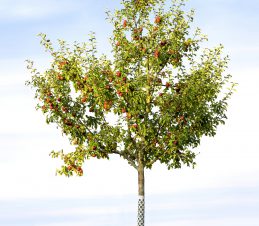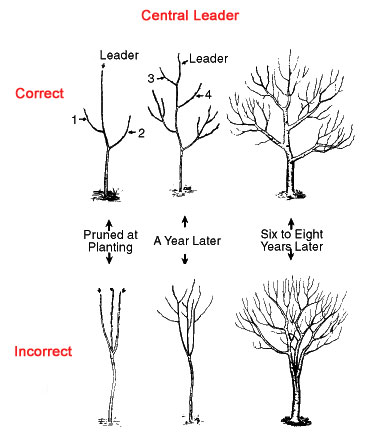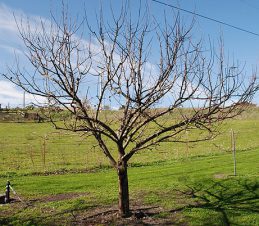
The day apple trees are planted is the day to begin to train and prune them for future fruit production. Too often people plant apple trees and leave them untended for several years. This neglect results in poor growth, as well as delayed and under-sized fruiting.
The following pruning styles are if you have recently purchased, or own a young tree, and need to determine its shape as a mature tree.
-
Pruning Styles
Central Leader Training to a central leader produces a tree that has a pyramid shape.
Training to a central leader produces a tree that has a pyramid shape.If your newly planted tree is a whip (it has no branches and looks like a long stick) cut the trunk at a height of about 32 inches (81 cm). This will stimulate branches to grow along the trunk, and the topmost bud will become the central leader.
For a new tree that already has side branches, cut back the trunk to 32 inches (81 cm). Cut off any branches along the trunk between the ground and 24 inches (61 cm) high. Cut back any remaining side branches to 2 to 4 inches (5-10 cm), leaving no more than 2 buds on each branch stub.
First Summer: Make sure the top shoot becomes the leader. Pinch back all other shoots.
First Winter: If there has been a lot of new growth, choose 3 to 5 branches for the first set of scaffold branches. These branches should spiral around the trunk with about 4 inches (10 cm) vertical distance between each branch. Cut off the other side branches and any vertical branches that may compete with the leader. Prune back the main leader shoot, but keep it as the highest part of the tree to maintain your pyramid shape.
Second Summer: Make sure that the top shoot is growing vertically, cut off any competing shoots.
Second Winter: Select another set of scaffold branches 2 to 3 feet (.61-.91 m) higher than the first set. If the tree didn’t grow enough the second year, do this the third winter.
Thereafter: Keep doing the above until you have 3 or 4 sets of scaffold branches. Then simply keep that shape by pruning out watersprouts and any crossing, diseased, or unwanted branches. Try to keep the lower branches longer than the upper ones to maintain the shape.
-
Open Centre

Open Centre Pruned Apple Tree
Apples trained with an open center form a vase-shaped tree with no central leader; instead, several major branches angle outward and upward from the top of the trunk.
Cut back the newly planted tree to 24 to 32 inches (61-81 cm), depending on how low you want the major branches to form. Choose strong, well-spaced branches that are 6 to 10 inches (15-25 cm) below the cut to become primary scaffold branches.
If the young tree has some side branches, cut back the leader to 24 to 32 inches (61-81 cm). Select well-placed side branches that point out from the trunk in different directions 6 to 10 inches (15-25 cm) below the cut to become scaffold branches.
Cut back the selected branches to 2 to 4 inch (5-10 cm) stubs, and cut off all the other side branches. By the end of the first growing season, the major scaffold branches should be formed.
-
Espalier or Cordon (meaning rope)
You can grow apples as espaliers as ornamentals against walls or fences, along wires, or on lattices. Semi-dwarf varieties are the best choices because they grow slower and require less pruning than full-size varieties.
Simply train the branches into the shape you want, or along a fence or wall. Every year, prune to shape.
Direct its growth by pruning frequently during the growing season and during the dormant season to guide it into the shape you want. It may take several years of training before the tree conforms to the shape you want it to take.
